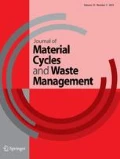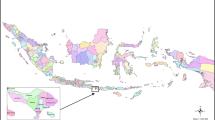Abstract
Industrial ecology and models such as material flow analysis make operational approaches in order to reuse produced waste as primary resources in other industrial units. In this study, using these concepts and the material flow model, the waste flow network between some of the units in Ghazvin industrial estate have been analyzed. 38 industrial units from the total 220 active units in the estate were visited and quantitative and qualitative information regarding the production process of the plant, waste production, and primary resource consumption was collected. According to the flow model being considered at the estate, a trade plan for 6 types of waste in the estate was presented. In total, 341.6 tons which equals 38% of the produced waste in these industrial units is reusable in this complex. To follow economic analysis in the raw waste, economic value stage was carried out which lead to a 1.43 million US dollar annual income and 256 thousand dollar saving in the loading and transport area. Finally, topics such as database, clustering, and location of industry in this estate were analyzed and discussed based on industrial ecology concepts.



Similar content being viewed by others
References
Ayres RU, Ausubel JH, S. HE (1989) Technology and environment. National Academy Press, Washington, DC, pp 23–49
Ayres RU, K AV (1969) Production, consumption, and externalities. Resources for the Future, Washington, DC
Watanabe C (1972) Industrial-ecology: introduction of ecology into industrial policy. Ministry of International Trade and Industry (MITI), Tokyo
Billen G et al (1983) L’écosyste`me belgique. Essai d’e´cologie industrielle. Centre de Recherche et d’Information socio-politique (CRISP)
Frosch RA (1995) Industrial ecology: adapting technology for a sustainable world. Environment 37(10):16–28, 34
Gibbs D, Deutz P (2005) Implementing industrial ecology? Planning for eco-industrial parks in the USA. Geoforum 36(4):452–464
Baas LW, Huisingh D, Hafkamp WA (2000) Four years of experience with Erasmus University’s “International Off-Campus PhD programme on cleaner production, cleaner products, industrial ecology and sustainability”. J Clea Prod 8(5):425–431
Korhonen J (2001) Regional industrial ecology: examples from regional economic systems of forest industry and energy supply in Finland. J Environ Manag 63(4):367–375
Singhal S, Kapur A (2002) Industrial estate planning and management in India—an integrated approach towards industrial ecology. J Environ Manag 66(1):19–29
Seager TP, Theis TL (2002) A uniform definition and quantitative basis for industrial ecology. J Clea Prod 10(3):225–235
Korhonen J, Savolainen I, Ohlström M (2004) Applications of the industrial ecology concept in a research project: Technology and Climate Change (CLIMTECH) Research in Finland. J Clea Prod 12(8–10):1087–1097
Seager TP, Theis TL (2004) A taxonomy of metrics for testing the industrial ecology hypotheses and application to design of freezer insulation. J Clean Prod 12(8–10):865–875
Chiu ASF, Yong G (2004) On the industrial ecology potential in Asian Developing Countries. J Clean Prod 12(8–10):1037–1045
Korhonen J (2004) Industrial ecology in the strategic sustainable development model: strategic applications of industrial ecology. J Clean Prod 12(8–10):809–823
Kuo NW, Hsiao TY, Lan CF (2005) Tourism management and industrial ecology: a case study of food service in Taiwan. Tour Manag 26(4):503–508
Dewulf J, Van Langenhove H (2005) Integrating industrial ecology principles into a set of environmental sustainability indicators for technology assessment. Resour Conserv Recycl 43(4):419–432
Diwekar U (2005) Green process design, industrial ecology, and sustainability: a systems analysis perspective. Resour Conserv Recycl 44(3):215–235
Phillips PS et al (2006) A critical appraisal of an UK county waste minimisation programme: the requirement for regional facilitated development of industrial symbiosis/ecology. Resour Conserv Recycl 46(3):242–264
Basu AJ, Van Zyl DJA (2006) Industrial ecology framework for achieving cleaner production in the mining and minerals industry. J Clean Prod 14(3–4):299–304
Indrianti N, Matsuoka S, Muraki M (2006) A management framework for the implementation of policies for industrial ecology, part I. Progress in industrial. Ecology 3(3):176–191
Cervantes G (2007) A methodology for teaching industrial ecology. Int J Sustain High Educ 8(2):131–141
Wang H et al (2008) Discussion of China water power exploitation strategy under the challenge of energy and environment safety. Tianjin Daxue Xuebao (Ziran Kexue yu Gongcheng Jishu Ban)/J Tianjin Univ Sci Technol 41(9):1062–1067
DeLaurentis DA, Ayyalasomayajula S (2009) Exploring the synergy between industrial ecology and system of systems to understand complexity a case study in air transportation. J Ind Ecol 13(2):247–263
Sun X, Zhou M (2010) Performance evaluation of transformation of industrial ecology in the resource-based cities. In: Proceedings of the international conference on E-business and E-government, ICEE
Ardente F et al (2010) Life cycle assessment-driven selection of industrial ecology strategies. Integr Environ Assess Manag 6(1):52–60
Ruiz MC (2011) Industrial ecology in the planning and management of industrial parks. In: Environmental planning, pp 203–220
Albu A (2011) Business innovation using industrial ecology. Metal Int 16(7):36–39
Petrie J, Kempener R, Beck J (2012) Industrial ecology and sustainable development: dynamics, future uncertainty and distributed decision making. In: Sustainability: multi-disciplinary perspectives, pp 243–272
Liu C, Zhang K (2013) Industrial ecology and water utilization of the marine chemical industry: a case study of Hai Hua Group (HHG), China. Resour Conserv Recycl 70:78–85
Nieuwenhuis P, Lammgård C (2013) Industrial ecology as an ecological model for business: diversity and firm survival. Progress in Industrial. Ecology 8(3):189–204
Boons F (2013) Ecological modernization and industrial ecology. In: The handbook of global companies, pp 388–402
Schiller F, Penn AS, Basson L (2014) Analyzing networks in industrial ecology—a review of Social-Material Network Analyses. J Clean Prod 76:1–11
Cerceau J et al (2014) Implementing industrial ecology in port cities: international overview of case studies and cross-case analysis. J Clean Prod 74:1–16
Leigh M, Li X (2015) Industrial ecology, industrial symbiosis and supply chain environmental sustainability: a case study of a large UK distributor. J Clean Prod 106:632–643
Xu J et al (2015) System dynamic modelling of industrial growth and landscape ecology in China. J Environ Manag 161:92–105
Smith RL et al (2015) An industrial ecology approach to municipal solid waste management: I. Methodology. Resour Conserv Recycl 104:311–316
Smith RL et al (2015) An industrial ecology approach to municipal solid waste management: II. Case studies for recovering energy from the organic fraction of MSW. Resour Conserv Recycl 104:317–326
Allen DT, Rosselot KS (1994) Pollution prevention at the macro scale: flows of wastes, industrial ecology and life cycle analyses. Waste Manag (Oxford) 14(3–4):317–328
Lowe EA, Evans LK (1995) Industrial ecology and industrial ecosystems. J Clean Prod 3(1–2):47–53
Chertow MR (2008) Industrial ecology in a developing context. In: Sustainable development and environmental management: experiences and case studies, pp 335–349
Brand E, de Bruijn T (1999) Shared responsibility at the regional level: the building of sustainable industrial estates. Eur Environ 9:221–231
Boix M et al (2015) Optimization methods applied to the design of eco-industrial parks: a literature review. J Clean Prod 87:303–317
Pan M et al (2015) Applying industry 4.0 to the Jurong Island eco-industrial park. Energy Proc 75:1536–1541
Korhonen J (2001) Four ecosystem principles for an industrial ecosystem. J Clean Produ 9(3):253–259
Roberts BH, Greenhalgh E (2000) Planning for eco-industrial parks to facilitate industrial ecologies in SE Queensland. In: Proceedings of the conference shaping the sustainable millennium, Brisbane
ISIPO (2015) http://isipo.ir/?part=menu&inc=menu&id=79
Farzadkia M et al (2015) Industrial Waste Management in Shokuhieh Industrial zone of Qom province in 2013. Iran Occup Health 12(5):64–74
Hoveidi, Hassan et al (2013) Industrial waste management with application of RIAM environmental assessment: a case study on toos industrial state, Mashhad. Iran J Energy Environ 4(2):142–149
Abedinzadeh F, Monavari SM (2007) Study of solid waste management in industrial estate of Rasht, pp 101–118
Mansoorian HJ et al (2014) Evaluation of solid waste recycling in Khazra Industrial estate, Iran. Int J Environ Health Eng 3(1):5
Roberts BH (2004) The application of industrial ecology principles and planning guidelines for the development of eco-industrial parks: an Australian case study. J Clean Prod 12(8–10):997–1010
Acknowledgements
The authors of this study would like to thank engineer Mehdi Hosseinpour for his help in field inspections and also Ms. Zahra Mohseninia and Ali Rashidi for collecting information for the industries.
Author information
Authors and Affiliations
Corresponding author
Rights and permissions
About this article
Cite this article
Vahidi, H., Hoveidi, H., Khoie, J.K. et al. Analyzing material flow in Alborz industrial estate, Ghazvin, Iran. J Mater Cycles Waste Manag 20, 450–460 (2018). https://doi.org/10.1007/s10163-017-0601-9
Received:
Accepted:
Published:
Issue Date:
DOI: https://doi.org/10.1007/s10163-017-0601-9




